Some things never change - as in yet another accident on the A588 at Burned House Lane where Police cars blocked the road, necessitating a detour to get to Pilling. A biker and a Mini Cooper this morning, two or more people who didn’t arrive at work on time.
After the high temperatures of Skiathos and its Mediterranean birds the sought after hot spots today were local birding haunts to reacquaint myself with mundane but nevertheless good-to-see UK regulars. After almost three weeks of absence a number of things struck me. Not least was the presence of good numbers of recently arrived Pink-footed Geese here for the winter, and the fact that there are still Barn Swallows lingering from the summer. Swallows were immediately obvious, at least a hundred over the wheat fields and on roadside wires at Fluke Hall Lane and then good numbers flying noticeably south and west throughout the morning at Conder Green and later at Lane Ends/Pilling Water. I must have counted several hundred Swallows in total, with just 2 House Martins noted at Pilling Water.
Barn Swallows
Was there was plenty of rain while I was away? That was clear from flash pools here and there and the water levels at Conder Green where nothing much came my way save for a latish Common Sandpiper, 2 Snipe, 1 Little Egret, 1 Cormorant, 6 Little Grebe and a Kingfisher.
A quick look at Glasson gave 2 Grey Heron, 250+ Lapwing and 300 or more Redshank along the river, some wading as waders should, others picking over the muddy shore.
Redshanks
Lane Ends beckoned. A single Jay and probably more called from the trees as a small group of Goldfinches dropped into the tree tops, but I didn’t linger and instead set off for Pilling Water. Grounded along the tideline were a single Wheatear, 4 Skylark and a small number of Meadow Pipits, all flying off on my approach, with the remainder wildfowl or waders at high tide time.
What a difference three September weeks make to duck numbers, with today upwards of 400 Wigeon, 1100 Teal, 15 Pintail and 900+ Pink-footed Geese. Wader numbers were equally impressive if imprecise on a less than ideal tide height leaving many roosting on the higher marsh at Fluke Hall: 5 Little Egret, 1 Grey Heron, 6 Snipe, 2 Black-tailed Godwit, 400+ Lapwing, 700+ Curlew, 40 Redshank and 4 Ringed Plover. No count of gulls, but a dozen Sandwich Terns were good to see so far into the bay.
Wigeon
Sandwich Terns
That Greek holiday seems like a distant dream in a far off sunny spot but sometimes isn't it good to get back to basics on a local patch?
Heading Home - Skiathos
Log in soon for more uncomplicated birding from Another Bird Blog.

























































.jpeg)








.jpg)












